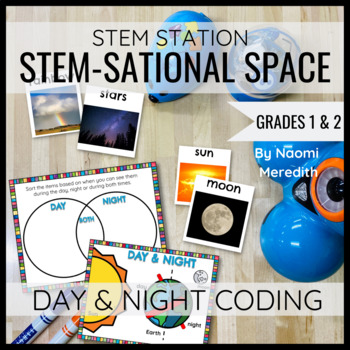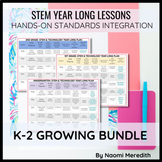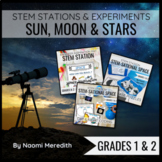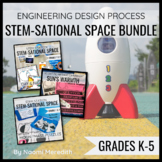Day and Night Lesson Plans for First Grade | Robot Coding and Unplugged
- Zip
Also included in
- Needing 1st grade STEM project ideas? In this growing bundle, lessons are one of a kind and have been used with real students before being added. They can be implemented in any classroom setting, not just STEM classrooms. Save time by using lessons already integrated with cross-curricular connectionPrice $56.60Original Price $70.75Save $14.15
- Needing Kindergarten, 1st & 2nd grade STEM project ideas? In this growing bundle, lessons are one of a kind and have been used with real students before being added. They can be implemented in any classroom setting, not just STEM classrooms. Save time by using lessons already integrated with croPrice $145.40Original Price $181.75Save $36.35
- Needing K-5 STEM project ideas? In this growing bundle, lessons are one of a kind and have been used with real students before being added. They can be implemented in any classroom setting, not just STEM classrooms. Save time by using lessons already integrated with cross-curricular connections. AllPrice $281.40Original Price $351.75Save $70.35
- Learn about the Sun, Moon and Stars with a variety of hands-on lesson for 1st and 2nd grades. These activities work well for station rotations so that students can have more experiences in less time. ==========================================Your Sun, Moon and Stars Lesson Plans come to life with thPrice $10.00Original Price $12.75Save $2.75
- Learn about the Sun, Moon & Stars and Earth's connection with a variety of lessons for K-5. Have hands-on, STEM experiences where students can design solutions, modify their designs, and share their work.==========================================STEM Challenges are a great way to encourage creatPrice $44.60Original Price $55.75Save $11.15
Description
What are things that we only see at night and things we only see during the day? After learning about what the difference between day and night is, students will code their robot (or use the unplugged option included) to collect items that can be seen during those times. While this can be used as a whole group activity, it is recommended to use as a station on conjunction with other related activities.
Multiple ways to play as well as a coding unplugged option.
==========================================
STEM Stations are a great way to encourage creativity, collaboration and critical thinking. With the tools that I created for you, it should save you time with prep and give you more time to provide an awesome experience for your kids.
Easy-Prep Materials to Create an Engaging STEM Station:
- STEM Challenge Cards
- Learn More About Day and Night Video Links & Reflection
- Day and Night Cards to code your robot to
- Coding Unplugged Activity Sheet
- Vocabulary Anchor Charts
*Day and Night
*Sunrise
*Sunset
*Dusk
*Dawn
*Sun
*Rainbow
*Moon
*Stars
*Clouds
*Shadows
*Meteors
*Aurora Borealis
Bonus!
- Audio recordings to accompany the digital versions of slides
==========================================
The one resource NOT included that you will need for this station are the robots. However, if you don't have access, there is an unplugged option where robots are not needed.
==========================================
Perfect for:
- Regular 1st and 2nd grade classrooms
- STEM/STEAM Labs & Makerspace
- Technology Classes
- Library & Media centers
- After-School Clubs
- Extension Groups
- Summer Clubs
- Specialized Classes
- Substitute/Sub Plans
===========================================
Next Generation Science Standards (NGSS):
1st Grade: 1-ESS1-1
Common Core State Standards:
1st Grade: RI.1.6, RI.1.10, W.1.6, W.1.8, SL.1.1
2nd Grade: RI.2.5, RI.2.10, W.2.6, W.2.8, SL.2.1
Mathematical Practices
Attend to Precision
ISTE Standards for Students
Global Collaborator
===========================================
How you will receive this product:
Various digital file types to meet your sharing needs
- PDF (non-editable, various sizes)
- Google Slides link
- PowerPoint file
- Seesaw activity
All Seesaw files are pre-loaded into activities. Upon purchase, you'll get the share link to copy & edit and add to your Seesaw Activity library, then assign to students. I saved you A LOT of steps!
How to assign digital versions to students:
- Google Slides pair perfectly with Google Classroom. Once you click the button, it will automatically make a copy for each student
- PowerPoint works well with Microsoft OneDrive users. Share with students within Microsoft Teams
- Seesaw Activities can be assigned to students and automatically make a copy. You can also use the Google Slides version if you students log in with their Google account
===========================================
When you purchase a product from my store, a portion of the proceeds will be donated to classrooms in need of technology to enhance their students’ learning experience.
===========================================
Need more STEM Stations for your classroom? Check out my growing list of products here!
===========================================
Connect with me for more inspiration!
Naomi Meredith
Navigating STEM & tech in the K-5 classroom.
Click here to be updated when new products are posted.
Instagram: @naomimeredith_










